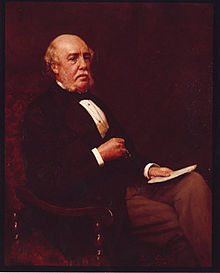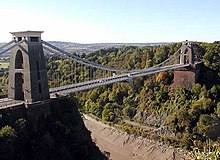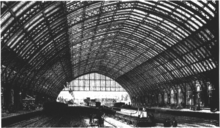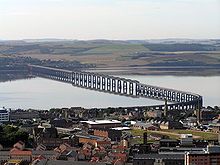William Henry Barlow
William Henry Barlow (born May 10, 1812 in Woolwich , Kent , † November 12, 1902 in Charlton , London ) was a British civil engineer, known for some bridge building projects and buildings for the railroad.
Life
He was the son of Peter Barlow (1776–1862), who taught mathematics and physics at the Woolwich Military Academy. His brother Peter William Barlow (1809-1885) was also a civil engineer who designed bridges (Lambeth Bridge) and invented an improved tunnel shield.
Barlow received his training from his father, in the Royal Navy shipyard in Woolwich and in the docks of London under the engineer Henry Robinson Palmer (1795-1844). From 1832 to 1838 he was in Turkey, where he built a machine factory for Maudslay, Sons and Field and inspected the lighthouses on the Bosporus for the Turkish government. Back in England he worked first for the Manchester and Birmingham Railway and from 1842 for the Midland Counties Railway. This was taken over in 1844 by the Midland Railway , in which he later became chief engineer. In 1849 he patented his own railroad track (Barlow Rail), which could be laid directly on the gravel bed without sleepers. In 1851 he assisted Joseph Paxton with static calculations for his Crystal Palace at the World's Fair in London (Paxton was a director of the Midland Railway).
In 1857 he opened his own engineering office, which continued to work a lot for the Midland Railway. With John Hawkshaw (1811-1891) he was commissioned to complete the Clifton Suspension Bridge of Isambard Kingdom Brunel after his death. The work had previously been long and completed in 1864, using chains from Brunel's Hungerford Suspension Bridge, which had been demolished in 1860. With a span of 214 m, the Clifton Bridge was the longest suspension bridge in Great Britain in its time.
From 1862 to 1869 he was also a consulting engineer for the south expansion of the Midland Railway from Bedford to London and designed, among other things, the steel structures and the main hall of St Pancras station , which at the time was leading with a span of 73 m.
After the collapse of the Tay Rail Bridge Barlow served as newly elected President of the Institution of Civil Engineers , the investigation, which the designer Thomas Bouch zuwies a major portion of the blame. Another consequence was the establishment of a commission to investigate wind loads on railway structures (bridges), of which he belonged. From 1882 to 1887 Barlow oversaw the construction of the second bridge over the Firth-of-Tay with his son.
He undertook experimental studies on the load-bearing capacity of steel in Woolwich in the 1850s and was a member of a commission that proposed safe load limits for steel structures for railways (1877). He also published a sound recording device in 1874.
In 1896 he retired.
He was a Fellow of the Royal Society (1850) and its Vice-President in 1881, and he was a Fellow of the Royal Society of Edinburgh from 1887 .
He was married to Selina Crawford Caffin and had four sons and two daughters. His son Crawford Barlow also became a civil engineer and worked with him.
Web links
| personal data | |
|---|---|
| SURNAME | Barlow, William Henry |
| BRIEF DESCRIPTION | British civil engineer |
| DATE OF BIRTH | May 10, 1812 |
| PLACE OF BIRTH | Woolwich |
| DATE OF DEATH | November 12, 1902 |
| Place of death | Charlton , London |




